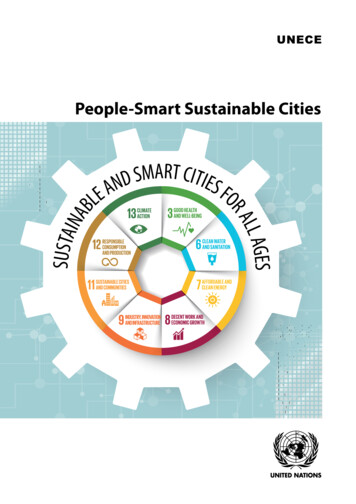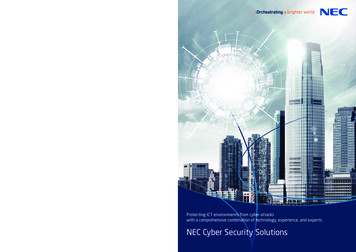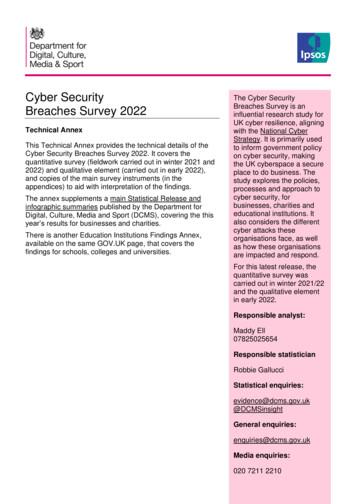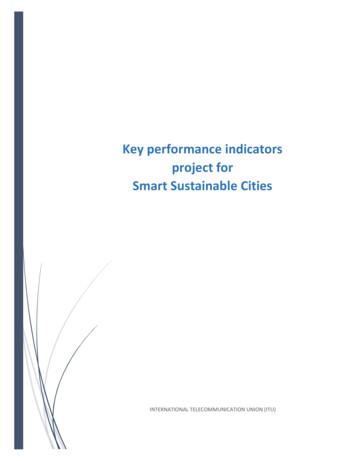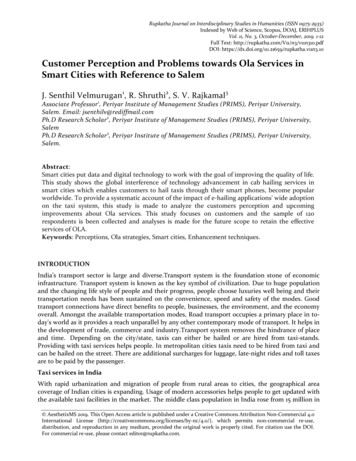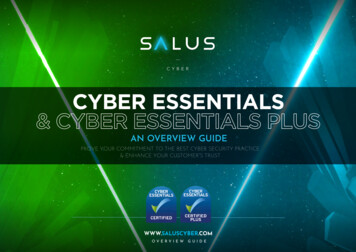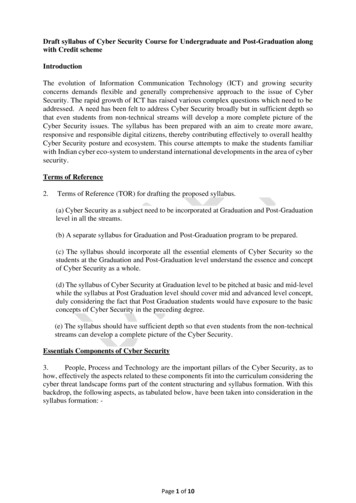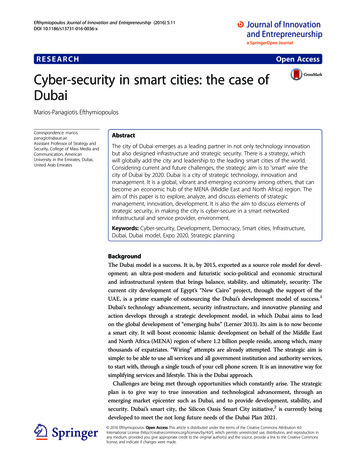
Transcription
Efthymiopoulos Journal of Innovation and Entrepreneurship (2016) 5:11DOI 10.1186/s13731-016-0036-xRESEARCHOpen AccessCyber-security in smart cities: the case ofDubaiMarios-Panagiotis EfthymiopoulosCorrespondence: marios.panagiotis@aue.aeAssistant Professor of Strategy andSecurity, College of Mass Media andCommunication, AmericanUniversity in the Emirates, Dubai,United Arab EmiratesAbstractThe city of Dubai emerges as a leading partner in not only technology innovationbut also designed infrastructure and strategic security. There is a strategy, whichwill globally add the city and leadership to the leading smart cities of the world.Considering current and future challenges, the strategic aim is to 'smart' wire thecity of Dubai by 2020. Dubai is a city of strategic technology, innovation andmanagement. It is a global, vibrant and emerging economy among others, that canbecome an economic hub of the MENA (Middle East and North Africa) region. Theaim of this paper is to explore, analyze, and discuss elements of strategicmanagement, innovation, development. It is also the aim to discuss elements ofstrategic security, in making the city is cyber-secure in a smart networkedinfrastructural and service provider, environment.Keywords: Cyber-security, Development, Democracy, Smart cities, Infrastructure,Dubai, Dubai model, Expo 2020, Strategic planningBackgroundThe Dubai model is a success. It is, by 2015, exported as a source role model for development; an ultra-post-modern and futuristic socio-political and economic structuraland infrastructural system that brings balance, stability, and ultimately, security: Thecurrent city development of Egypt’s “New Cairo” project, through the support of theUAE, is a prime example of outsourcing the Dubai’s development model of success.1Dubai’s technology advancement, security infrastructure, and innovative planning andaction develops through a strategic development model, in which Dubai aims to leadon the global development of “emerging hubs” (Lerner 2013). Its aim is to now becomea smart city. It will boost economic Islamic development on behalf of the Middle Eastand North Africa (MENA) region of where 1.2 billion people reside, among which, manythousands of expatriates. “Wiring” attempts are already attempted. The strategic aim issimple: to be able to use all services and all government institution and authority services,to start with, through a single touch of your cell phone screen. It is an innovative way forsimplifying services and lifestyle. This is the Dubai approach.Challenges are being met through opportunities which constantly arise. The strategicplan is to give way to true innovation and technological advancement, through anemerging market epicenter such as Dubai, and to provide development, stability, andsecurity. Dubai’s smart city, the Silicon Oasis Smart City initiative,2 is currently beingdeveloped to meet the not long future needs of the Dubai Plan 2021. 2016 Efthymiopoulos. Open Access This article is distributed under the terms of the Creative Commons Attribution 4.0International License (http://creativecommons.org/licenses/by/4.0/), which permits unrestricted use, distribution, and reproduction inany medium, provided you give appropriate credit to the original author(s) and the source, provide a link to the Creative Commonslicense, and indicate if changes were made.
Efthymiopoulos Journal of Innovation and Entrepreneurship (2016) 5:11This paper attempts to explore and critically analyze the Dubai strategic development citymodel. As per the interests of this model, it concentrates on the smart city initiative design and application for the city of Dubai. It will also project the need forsmart cyber-security.Dubai is the model city example, per the needs of this current paper. Twenty-firstcentury security and stability in the MENA region is projected through this city whichprovides innovation and strategic development in reality. The paper describes not onlythe current but also the future needs of the MENA region and its people. Thedescribed and analyzed model of this paper will be surely exported in other countriesin need. It will have a direct interest to global governance and regional security. It willallow for direct foreign investment (DFI).This paper holds a multi-disciplinary approach. It puts forward combined proposals in the field of business and economic development, security, and strategicmanagement processes. It reflects the topic of grand strategy and security,innovation, and infrastructure. It is a paper that explores the city of Dubai and addsvalue to the new policy orientation of cyber-security in the strategic attempt tomake the city smart and on the way for Dubai to welcome the “Dubai 2020 WorldExposition”.3The epicenter that is called DubaiDubai is a vibrant city.4 It is a new city. A city which competes itself in infrastructure, services, and goods, complete with multi-national and multi-cultural environments. Dubai is one of the new and emerging “lands of opportunities”, anemerging world, merged in a single city, complete with ideas and suggestions thatare actually put to the test in a globalized and multi-cultural environment.Dubai is a city of both innovation and luxury at the same time. It is a city of ultramodern architectural design in its complete infrastructure. The design of the city andits already offered services are carefully selected and constructed. It is an innovativeengineered city, from its sewage system, which is applied in former desert and movingsand area in a new environment and structures that fit the needs of newly comingresidents, which are ever increasing in numbers.5Dubai is a crossroad, a new world city that supersedes expectations on global livingstandards and affordable services. It offers clear lifestyle, luxury combined with architectural innovation, high-level and high-tech services, while living expenses are skyrocketing year by year making Dubai one of the most expensive cities to live in. “Overthe last decades Dubai, has applied an economic development model which is stronglypro-business, emphasizes market liberalism and economic openness, and embracesglobalization ” (Hvidt 2011).Today, Dubai is becoming a large and global market competitor, a hub of transportand services (Hvidt 2011). Its citizens, in its majority expatriates (expats), count as8,264,070 in a 43-years-of-age country. Its local population, "Emirate Nationals" countaccording to the National Bureau of Statistics and the most recent census of 2010 as974,997 peoples.6The United Arab Emirates (UAE) was and is envisioned through its founder SheikhZayed bin Sultan al Nahayan, whose dedication was to preserve architectural and livingPage 2 of 16
Efthymiopoulos Journal of Innovation and Entrepreneurship (2016) 5:11heritage (Schneider 2012). The UAE’s strategic vision today in its global form promotesnot only UAE’s heritage and culture but also a global cultural development, processesand actions through innovation, and smart-thinking, planning, and action. The UnitedArab Emirates comprises seven emirates, Abu Dhabi, Ajman, Dubai, Fujairah, Ras AlKhaimah, Sharjah, and Umm Al-Quwain, located along the southeast coast of the Arabian Peninsula. The country covers an area of around 84,000 km2.7Dubai, which is the capital of the Emirate of Dubai, according to Hvidt, has shownthat through innovation, strategic investment, branding, and openness to globalization,Dubai has been able to transform a backwater, oil-poor Arab city-state into an international metropolis.8 Today, Dubai seemingly competes itself. It also wants to competewith the world in the fields of innovation and technology through prime-provided services and infrastructures. Dubai, as New York, is a city that “never sleeps”. Dubai is a“production machine city”. A city of branding elements that combine and merge witheach other and visionary approaches that come to being in practice. Complete with engineering plans, from city landscape, architecture, social commodities, and now, socialinfrastructures, Dubai is an example city of innovative methodological and practical approaches to what we may call true city and country development. It offers to the localsan increasingly emerging GDP per capita and per family, so as also to the expatriatesjoining forces, while they wish to mix with a multi-cultural, multi-religious, and multinational environment truly from around the world. Dubai’s anthropological idiosyncrasy projects how big in population, cultures, and civilization the planet is, a socialstructure that is bonded by the global rules and regulations of the international community; while respecting local religion, culture, and heritage, it offers true opportunityto those that seek to not only invest but also innovate while Dubai is increasingly becoming a hub between the Western Hemisphere and the Eastern Hemisphere.9Dubai, whose actual name according to the local national Emiratis is pronounced asDubayy, is one of the most popular cities in the world.10 Its geographic location’s coordinates are 25 15′ 8′′ North, 55 16′ 48′′ East. Dubai is part of the United Arab Emirates;the Emirate of Dubai, which counts as one out of the seven Emirates, is now set to become a “smart city” by the year 2020, according to His Highness, the Vice President of theUAE and ruler of Dubai, Sheikh Mohammad bin Rashid Al Maktoum.11DiscussionStrategic development of DubaiDubai is a business hub for the Arab Peninsula and the MENA region. By the 1960s,Dubai’s economy was based mainly on revenue from trade, whether trade was associated with sea trade and old historical desert trade elements. However, oil discoveries by1966 made both Dubai and Abu Dhabi the key source, from which revenue would flow,starting 1969, for the city of Dubai.12Oil revenue accelerated actual true development for the city of Dubai, for the shortterm, adding Dubai to the world map of developing and emerging cities. Up to the dayof oil discovery in 1966, Dubai was known for its port trade, through the old city andport of Deira and through the gold market “Souk” mostly known for diamond hubsand 18-ct gold with great clarity in its gold trade. Oil, nonetheless, would soon becomethe key aspect value for money, giving way to a strategic plan for construction andPage 3 of 16
Efthymiopoulos Journal of Innovation and Entrepreneurship (2016) 5:11mass development in infrastructure, service providence, and transport hub, makingDubai a western, global-friendly, capitalist city.An innovative model economy of architectural design, services, and later on,innovation would seemingly emerge, as a possible driving force for true development.13Its true fast-track development would offer the thought of a true leading, initially theArab Peninsula region of emerging countries and forward in the years to come, theMiddle East, totaling an opportunity for growth which counts today as 1.2 billionpeople, a great emerging market share considering both the opportunities to expandand grow but also the emerging trade agreements with other emerging economies,mainly in the Asian regions and the African developing regions.Oil reserves supported all strategic options for fast-track actual growth in all levels ofnecessary social and market structures. Its strategic location as it stands today is an “association between market orientation and business performance” (Ben Brik et al. 2011).Long-term and grave geostrategic and geopolitical changes of the twentieth centuryprovided an opportunity for Dubai, to raise a modern and safe city in a strategic location giving way to the twenty-first century intelligent, high-tech, high-level architectureand services that bring about a sense of psychological security among others.Many assume that Dubai is solely an oil revenue city, but it is not. It is also an exporter of services and now innovation and safety procedures. Dubai could not assume aleading position and would never render a leading position if it would not sign for along-term executive and strategic plan of and for global development. Dubai forecastsinnovation and technology. It combines lifestyle and smart applications among others.It is secure and stable. Dubai can render a dream of lifestyle into reality while makingsure all elements of futuristic progress is applied.Dubai does not lack any sources or materials. It has great services and is a great service provider. It is a competitive global-friendly city. Dubai is a capitalist city, whichvery soon will emerge to become a key point for contact on global trade and effectiveengagement. Dubai’s capitalist system is believed to now have given way to a new corporate structure, a corporate relations framework, and social-global reconstruction,through economic and technological advancements, the aforementioned elements being the three key elements of multi-civilizational success and corporate or social responsibility actions (Ben Brik et al. 2011). The emergence of these emblematicelements of societal and large and impressive structures of this modern day city nowprojects slowly giving way to service providence, making sure Dubai remains an attractive place to invest and to live in.Dubai is a vibrant city, effective and creative. It creates or upgrades all necessary infrastructures. Through organograms, it allows for multi-layers of services and actionplans which come into reality. Dubai’s grand strategy estimates on how and what thecity should look like, feel like, and what it takes to be offered or constructed which willbring a constant and continuous change. Dubai, as a global city, interacts as a strategicfocal point with today’s world system of governance (Acuto 2010a). Its actions makethe city world renown. Its Executive Council is chaired by His Highness Sheikh Hamdan Bin Mohammed Bin Rashid Al Maktoum, Crown Prince of Dubai, seeks innovationand excellence, reaching governance to its best and highest quality framework.14Depending heavily on its million strong workforce coming from countries of theEastern Hemisphere like India (Meyer and Brysac 2011), Dubai is set to meet socialPage 4 of 16
Efthymiopoulos Journal of Innovation and Entrepreneurship (2016) 5:11and religious global needs, with which it will inaugurate a new era of constructivechange, to meet global expectations and a competitive market for the twenty-first century which are concentrated in around specific elements of stability, security, and excellent lifestyle residency expectations.A grand strategy for Dubai had to take place. The city, by 2015, is looking ahead toits grander role as a stabilizer of regional and global trade, program and action planning, resourcefulness, social openness, stability, and security in a constantly changinggeostrategic world, a city complete with technological advancements and innovationideas, processed through a new platform named as the epicenter of development andapplication, a smart city.The paper will describe and analyze in a multi-level and multi-disciplinary approach the“epicentric” needs of the twenty-first century Dubai, a research which was conducted duringthe complete year 2015. This research paper combines not only the elements of meetingthe trade and high technology demands for the 2020 World Expo objectives but also the2021 world technology objectives.15 This research paper is both an analysis and descriptionof a modern day successful, going “smart policy”, which potentially can turn into becomingthe Silicon Valley of the Arab world of 1.2 billion people, notwithstanding neighboring continents which now profit solely on the relevance of the location of the city of Dubai.As a non-disclosure statement when considering this paper, the author would like tostate that this work is entirely, and to its complete completion, under the responsibilityand authority of the author. It does not represent any government or university policies. These are results and ideas of the author derived from his ongoing experiences,work, and research, while residing and working in the city of Dubai as an assistant professor of international strategy and security at the American University in the Emirates.No research outcomes are therefore associated with any entity, institution, andorganization but are sole opinions and responsibility of opinions of the author himself.A grand strategy for Dubai: the World Expo 2020In order to achieve goals in the city of Dubai, one should have a clear overview of thestrategic objectives of what Dubai aims to become. Strategy, being one of the oldestpolicies in the world, mainly known for military and security purposes, applies today aswell to the market world, whether this is for development or other purposes, like marketing, management, and public or international affairs.16The World Exposition of 202017 was a bid for the city, one of all to come, that wouldwelcome in a yearly venue of more than 30 to 40 million people, exhibitors seeking totrade, to coordinate, and to meet other potential collaborators and seek potential cooperations. Following the example of major cities for world exposition making trade thesole authority for first contact and knowledge between other civilizations, somethingthe Arab world knows about quite well, Dubai follows the need for major events, whichwould request quite much change in current infrastructure and positioning of the government and its residents residing in the city. Following the first attempt of a world exhibition initially, held in London in 1851, the World Expo “aspires and strengthensconnection . It celebrates diversity and marvels at technological advances”.18The world expo is handled and exposed every 5 years to the global public not limitingall cities to have other world exhibitions. Nonetheless, world exposition makes each cityPage 5 of 16
Efthymiopoulos Journal of Innovation and Entrepreneurship (2016) 5:11that organizes the event an important city which is of global attention, and in the developing world, such important events give rise to a fast-track change and request forcurrent structures to be improved while new ones to be associated with.A focal meeting point for sharing innovation and technology, progress on programsof global concern, economic prosperity, world peace and security, sustainable growthand development, and direct foreign investment are some of the few elements of aworld exhibition city, which welcomes such events. They all run parallel to the globalvenues of constant and yearly run trade fairs. For the year 2020, Dubai will host theworld exposition for the first time since its creation as a vibrant city. It will market forthe first time the world’s fair in a region that has not been associated with global traderather than a local trade and point of service hub, marking Dubai as the global connector or world fair to be hosted in the Middle East, Africa, and South Asia.In a new landmark in the city of Dubai, the “expo city of 2020” will run for 6 months,according to the organizing committee from October 2020 to April 2021, markingalong the opportunity “the 50th Anniversary Golden Jubilee celebrations”. The exposition has a three-framework marketing and smart theme: Connecting Minds Creatingthe Future”, while Dubai seeks to re-invent the levels of social and corporate cooperation, services provided to the citizen, the resident, and the tourist through the touchof a button, through the thought of having a relaxing lifestyle, a living standard throughan “Anatolian-Arab understanding”.19For the complete set, the concept making and the centerpiece of exposition 2020,Dubai is named as Al Wasl Plaza, after Dubai’s historic name of “connection”. State-ofthe-art exposition pavilions are being created, interactive effects and journeys aroundthe globe in a single city that is now united and combines effective decision-makingwith state-of-the-art construction is the sole objective of the city. In this attempt, morethan 30,000 volunteers will render Dubai an innovative city, a city of growth, development, and innovation, combining smart achievements and a new infrastructure as amodel of world heritage and culture.In a state of technological interstateness and interconnection, where physical boundaries in the age of technology are no longer there, in an increasingly globally challenging environment, where geopolitical and geostrategic changes occur, Dubai is set tobecome “a platform for connectivity to help pioneer partnerships for growth but alsosustainability” for future people and future generations.Where sustainable growth borders smart cityDubai’s Executive Council,20 which was established in 2001, will head on with strategic growth projects. It has major strategic goals put in place; to manage projectsin an effective way, it combines effectiveness, positive outcomes, and technologicaland architectural advancements for the benefits of its residents and to also meetthrough project creation and making the sustainable growth environment requirements as put forward by the United Nations and committed by the UAE government. Major events, major works, and mega projects being sustainable andtechnologically advanced would testify for a prime and futuristic society, a societywhich is constantly on the move and constantly requests a swift and completechange in an emerging city with a multi-national and multi-cultural society.Page 6 of 16
Efthymiopoulos Journal of Innovation and Entrepreneurship (2016) 5:11The design of a sustainable growing city borders on the need for far-reaching commitments of energy and construction friendly to the environment, affordable and technologically advanced to the point of smart city goals and framework. The aim is to make Dubai orregions of it “smart” facilitating growth and knowledge through innovation and research.21A city in which all elements from basic transport, to infrastructure, business and government services are complete and interconnected with each other, connection and increased cooperation between people, business, and government is completed in an easyway. Through the touch of a button, through a cell phone, residents should be able toresolve all their standing issues with the government.The promotion of smart cities is a development plan for the residents and touristsvisiting Dubai. Dubai positions itself as a city where technology meets the requests andneeds of the twenty-first century, which is the century of technology, whether these arecomplex or simple requests, of and for everyday life and business.It promotes government effectiveness and allows for smart facilities. The aim is to facilitate as much as possible the government and the residents in request of informationand or support by the local or UAE government. As such, sustainable growth is metthrough development of energy and water efficiency with quality building standardsboth environmentally friendly and ready for smart use.The creation of the International Renewable Energy Agency, headquartered in AbuDhabi22, is part of a wider effort of the UAE to meet the commitments to the UnitedNations sustainable development.23 Therefore, within the smart city initiatives of citiesin the UAE, the capital Abu Dhabi and the city of Dubai, among other emirates, nowaim to combine effort and activities to meet the high standards of living but also affordable and sustainable living for the twenty-first century. These are globalized cities and“metropoles”, in which among others “impact the global environment organize andregulate worldwide, regional and national flows have a strategic governance capability and have the capacity to entertain representative as well as advocacy, relations withother entities ” (Acuto 2010b).The Smart City Initiative of 2013 and beyondAccording to Dubai Media news services, the city, by July 2015, is getting closer andcloser to becoming a smart city in practice24, in its wide network of both governmententities and city infrastructure. The Dubai police Traffic and Crisis Management Control Center, which observes and reacts in case of a crisis management, has by now managed to connect all 408 signals of the Road and Transport Authority with theoperational center25, an operational center which works based on the city-wide attemptto use 3G and 4G technology to wire all necessary infrastructures for the daily roadand transport effectiveness of the city. The completed work is part of the Smart CityInitiative of 2013 for a stronger and safer infrastructure of the city.26Considering the aforementioned example case, all necessary work to the infrastructure “grid” on the road and traffic signals has been already completed and new projectsare to follow which will “wire the city”. The new system of control of signals, as an example, is now linked through new grids and lines that are energy-efficient, easy to comprehend and use, and easy to be maintained. Possible “glitches” seem to be minimizedbut not eliminated, at which point we should consider possible security risks at hand inPage 7 of 16
Efthymiopoulos Journal of Innovation and Entrepreneurship (2016) 5:11terms of smart security and or cyber-security policies to Dubai’s current city and gridinfrastructure.The Smart City initiative was announced in May 2013, according to the Vice President and Ruler of Dubai, Sheikh Mohammad Bin Rashid Al Maktoum, Vice Presidentand Prime Minister of the UAE and Ruler of Dubai where all or most governmentagencies, need to be centralized and most importantly available online; giving surelyrise to a new element of research in which one may wonder about the security effectiveness in a wired-world: “Dubai Smart Government Department operates in harmonyand integration with all the departments and entities that come under the Governmentumbrella in Dubai Initially called Dubai eGovernment, the Department’s name waschanged in June 2013 to Dubai Smart Government, by HH Sheikh Mohammed Bin Rashid Al Maktoum, UAE Vice President and Prime Minister and Ruler of Dubai in linewith his initiative to transform to an era of smart government”.27By October 2015, the Dubai Government now offers direct public services, followedby the private sectors, including banking, transport, and logistic and tourism servicesand companies. The electronic format is concentrated in the form of smart applications, which we can use through our cell phones. All applications hold a complete capacity and can manage service requests. They simplify everyday life in Dubai and offerresidents and tourists quality services. Practically, this means that the Dubai government now offers over 2000 government services online, which are constantly updatedfor the needs of the residents and the citizens within the United Arab Emirates.Dubai’s Strategic Plan 2015–2021By 2014, Dubai’s Ruler His Highness Sheikh Mohammed Bin Rashid Al Maktoum alongwith the Chairman of the Executive Council of Dubai, and Crown Prince of Dubai HisHighness, Sheikh Hamdan Bin Mohammed Bin Rashid Al Maktoum inaugurated theDubai Strategic Plan 2021.28 Following the successful experience of the former Strategicplanning of 2007, which would come to completion by 2015, would render Dubai’sgrowth in practice in the following areas: trade, logistics, financial services, and tourism, which would in turn, attract the city of Dubai as a major investment city andtherefore would allow global and local social services to develop.By October 2015, the Strategic Council of Dubai has launched a global story of branding, marketing, management, and investment in which through an important social structure and platform of development will render Dubai as “the preferred place to live andwork, for people and visitors alike”. Dubai’s branded position as a global city now allowsfor what is expected as the “foundation is laid” for capacity building, creativity, innovation,and certainly prime research to create “a truly special future” for Dubai.According to the Strategic Planning, Dubai’s development framework by 2021 includes development in the sectors of the economy, the society, the people, the experience, the government, and lastly, the place.29 Each framework of model policy isassociated directly or indirectly with each other. Success can be complete if all jointframeworks are successfully implemented. Considering the interests and the importance of this research paper, we will lay importance and interests to the three followingsectors: the government, the experience, and the place. They interrelate and correlatewith each other. Through an analysis of each framework, we will be able to compile thePage 8 of 16
Efthymiopoulos Journal of Innovation and Entrepreneurship (2016) 5:11elements that need to be projected, namely in the field of cyber-security and cyberdefense for a smart, engaged, and futuristic living Dubai.The governmentDubai’s Smart Government, as aforementioned, goes hand in hand with the Dubai Strategic Framework of 2021. The latest describes “the future of Dubai, through holisticand complementary perspectives”. The framework is divided into six sectors that arenamed as “themes”. Three of which interest the purpose of this research: The theme of“place” discusses, proposes, and analyzes strategic aims and goals towards a more smartand sustainable city that we need to be aware of. The other two include the government theme and the experience theme. Each theme has performance indicators forwhich all strategic changes will apply for. Below, we describe and briefly analyze eachto comprehend the levels of development that actually Dubai is or seeks, while keepingin mind the fact that an e-security policy needs to be adopted for the protection of atruly modern and technologically advanced city.Smart and sustainable city:For the theme of smart and sustainable city, the key performance indicators are basedon the following elements: “Satisfaction with the current Dubai city infrastructure Rate of carbon dioxide emissions per GDP Annual so
Marios-Panagiotis Efthymiopoulos Correspondence: marios. panagiotis@aue.ae Assistant Professor of Strategy and Security, College of Mass Media and Communication, American University in the Emirates, Dubai, United Arab Emirates Abstract The city of Dubai emerges as a leading partner in not only technology innovation


